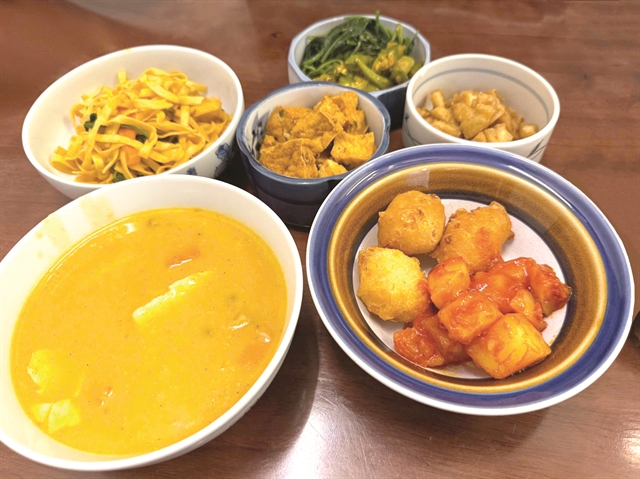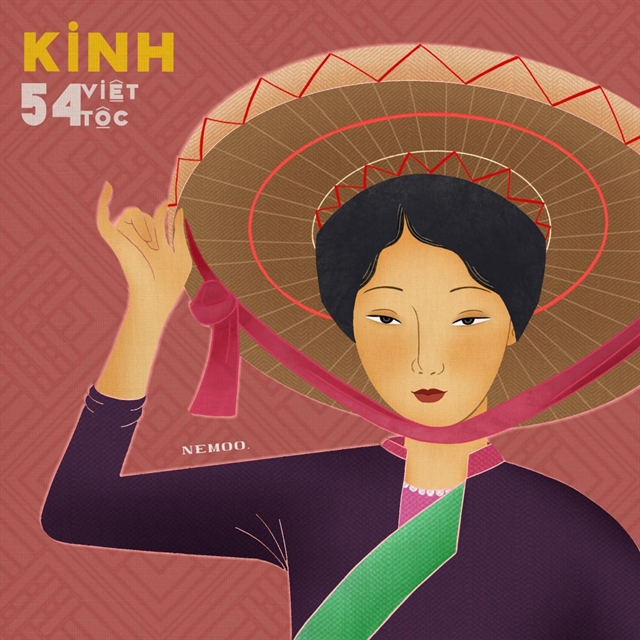 Features
Features
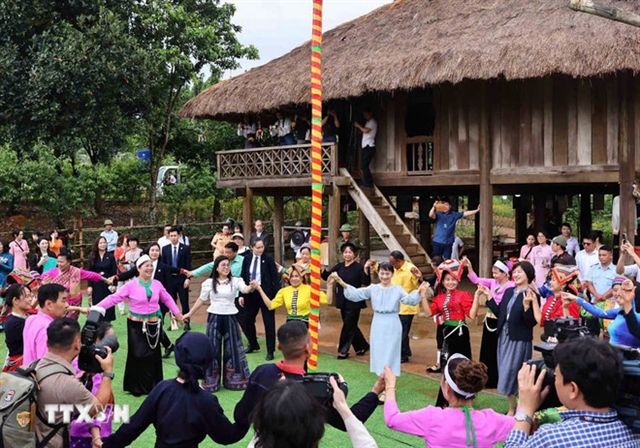
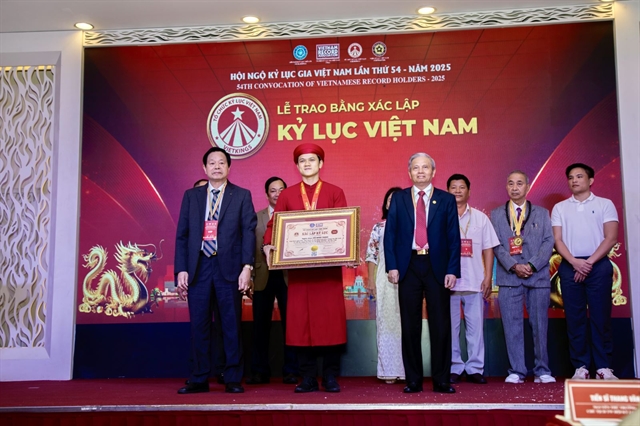 |
| Đỗ Nhật Thịnh receives the award for “Việt Nam Gấm Hoa”, a calligraphy painting that depicts the symbolic essence of the country and showcases Vietnamese calligraphy using diverse materials and techniques. VNA/VNS Photo Hương Trần |
Hương Trần & Lương Hương
Calligrapher Đỗ Nhật Thịnh has broken a national record for an impressive artwork inspired by three Declarations of Independence from three different periods in Vietnamese history.
The massive piece, a kind of mural on canvas measuring 25m in length by 1.85m in height, conveys a profound message of patriotism and the desire to connect the past with the younger generation through the art of calligraphy.
Entitled Việt Nam Gấm Hoa (Việt Nam -- A Land of Splendour), the monumental calligraphy work is considered the pinnacle of Thịnh’s career which he nurtured for five years and unveiled on the occasion of the 80th anniversary of National Day on September 2.
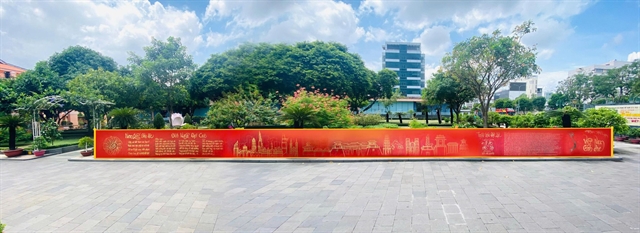 |
| The artwork 'Việt Nam Gấm Hoa' measures 25 metres in length and 1.85 metres in height. It took five years to finish. Photo courtesy of the artist |
Spanning nearly 50 square metres, Việt Nam Gấm Hoa was painted and written with gold leaf on a modern canvas backdrop, blending various traditional and contemporary materials from across the country, such as bamboo, wood lotus leaves, gold and silver leaf, wood, tea, ash, rice grains, coffee powder, soil, sand, and charcoal.
Art of independence
In this artwork, the artist transcribed three significant Declarations of Independence of the nation from three different historical periods -- Nam Quốc Sơn Hà (Mountains and Rivers of the Southern Country) by Lý Thường Kiệt (1076), Bình Ngô Đại Cáo (Great Proclamation of Victory) by Nguyễn Trãi (1428), and the Declaration of Independence by President Hồ Chí Minh (1945).
 |
| A section of the mural calligraphy work features the poem 'Nam Quốc Sơn Hà' (Mountains and Rivers of the Southern Country) by Lý Thường Kiệt from 1076, which is considered Việt Nam's first Declaration of Independence. Photo courtesy of VietKings |
“The three declarations are not just literary works; they embody the spirit of the nation throughout various historical periods. I chose to rewrite them as a way to connect the past with the present and the future, so that 80 years after President Hồ read the Declaration of Independence on September 2, 1945, today’s youth can look at each stroke and feel the patriotic blood flowing within them,” he said.
The artwork also features a depiction of Việt Nam’s map, distinctive architectural elements from the three regions, and the dragon from the Lý Dynasty (1009–1225), symbolising the nation's inner strength and unique identity.
The dominant red and yellow tones evoke the national flag, representing the blood and sacrifice of ancestors as well as the timeless essence of cultural heritage.
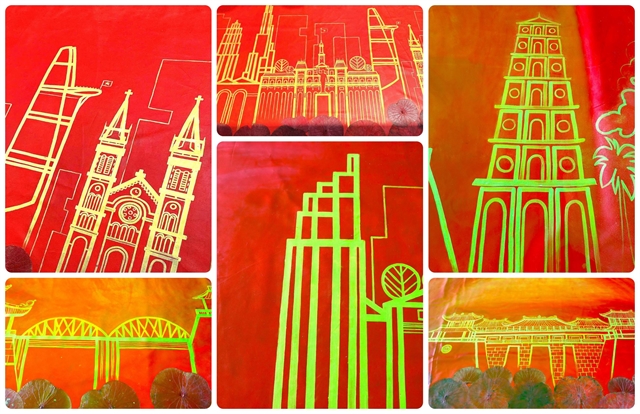 |
| Another section of the artwork depicts distinctive architectural landmarks from the three regions, blending various traditional and contemporary materials from across the country. Photo courtesy of VietKings |
“I hope that when young people view the artwork, they don’t just see the words but also perceive the history flowing through each stroke. Calligraphy is no longer an ancient art; it is a source of inspiration for creativity, integration, and the transmission of patriotic spirit,” Thịnh said.
The art of letters
Passionate about letters since his teenage years, Thịnh has introduced a fresh perspective to the art of calligraphy – youthful, dynamic and deeply connected to community life.
To infuse fresh vitality into the traditional art form, the 27-year-old artist has creatively combined the art of calligraphy with various colours and materials such as wood, fabric, stone, glass, mica, canvas, metal, clay, sawdust, and other materials from everyday life.
Through his dedicated efforts, Thịnh has brought Vietnamese calligraphy to nearly all provinces and cities across the country and to various nations worldwide, including Japan, Singapore, Thailand, Cambodia, France, and Australia.
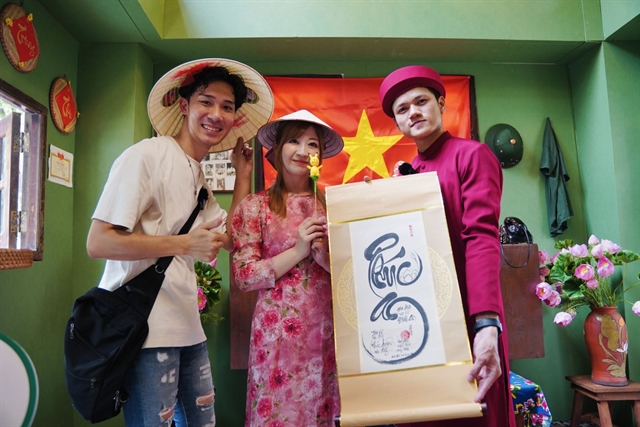 |
| Đỗ Nhật Thịnh (right) introduces Vietnamese calligraphy to international friends. VNA/VNS Photo Hương Trần |
He was among artists invited to participate in major Japanese festivals, such as Hello Saitama and the celebration of the 50th anniversary of Japan-Việt Nam diplomatic relations in 2023.
Thịnh also attended the Huế Festival - The Essence of Vietnamese Craft and the Unexpected Jumps exhibition alongside Belgian and French artists at the Hồ Chí Minh City Museum of Fine Arts, embodying the spirit of East-West connection through installation art and calligraphy.
His work has garnered public attention through notable domestic exhibitions such as Nét Chữ Tri Âm (The Lines of Understanding), Tổ Nghiệp (Ancestral Heritage), Bác Hồ Với Nhân Dân (President Hồ and the People) and Những Ngày Vấn Vương (Days of Remembrance). Each exhibition serves not just as a display but as a cultural dialogue, inviting the public to engage with calligraphy in a space closely connected to daily life.
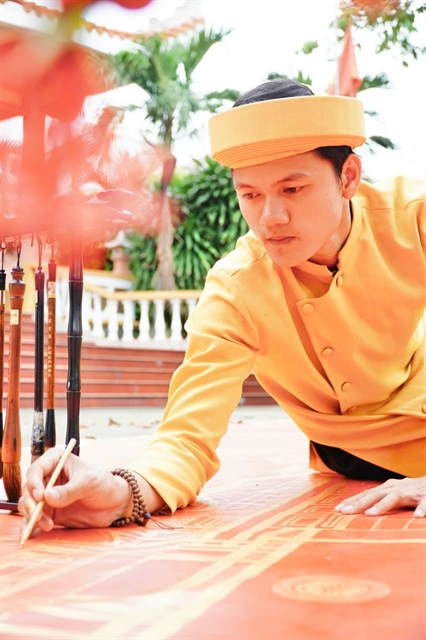 |
| The 27-year-old artist wishes to bring calligraphy closer to the community. VNA/VNS Photo Hương Trần |
Tradition reimagined
During his performances, Thịnh combines various forms of painting with calligraphy to create a lasting impression that earns high praise from audiences.
“Hearing international calligraphers praise my works, for their diverse forms, materials and layouts, brings me immense joy as Vietnamese calligraphy is gradually gaining recognition for its uniqueness and innovation,” he said.
According to him, research shows that Việt Nam was the first country to use the Eastern-style calligraphy brush to express a diverse range of forms in the romanised script [now used as the national script]. He also said that this approach established a deep connection between tradition and modernity, as well as between culture and the unique values of the nation.
In recognition of Thịnh’s efforts to integrate calligraphy into modern life, he has been awarded the titles "Artisan of Vietnamese Traditional Craft" and "National Artisan", making him the youngest calligrapher to receive both honours.
“Being honoured at the solemn ceremony in Hà Nội in front of deputies of the National Assembly, artists and businesspeople from all over the country is a great honour and also a sacred responsibility in the journey of preserving, creating and spreading Vietnamese calligraphy,” he said.
“Having received a scholarship to study in Singapore over a decade ago, I chose to stay in Việt Nam to enrich my learning and contribute to the country's vibrant art and culture. This recognition proves that my choice back then was indeed the right one,” the former valedictorian of the Hồ Chí Minh City Fine Arts University said.
“It is not only an acknowledgement of my long journey with the art of calligraphy but also a significant motivation for a young person to continue the mission of spreading traditional cultural values in the modern era.” VNS



